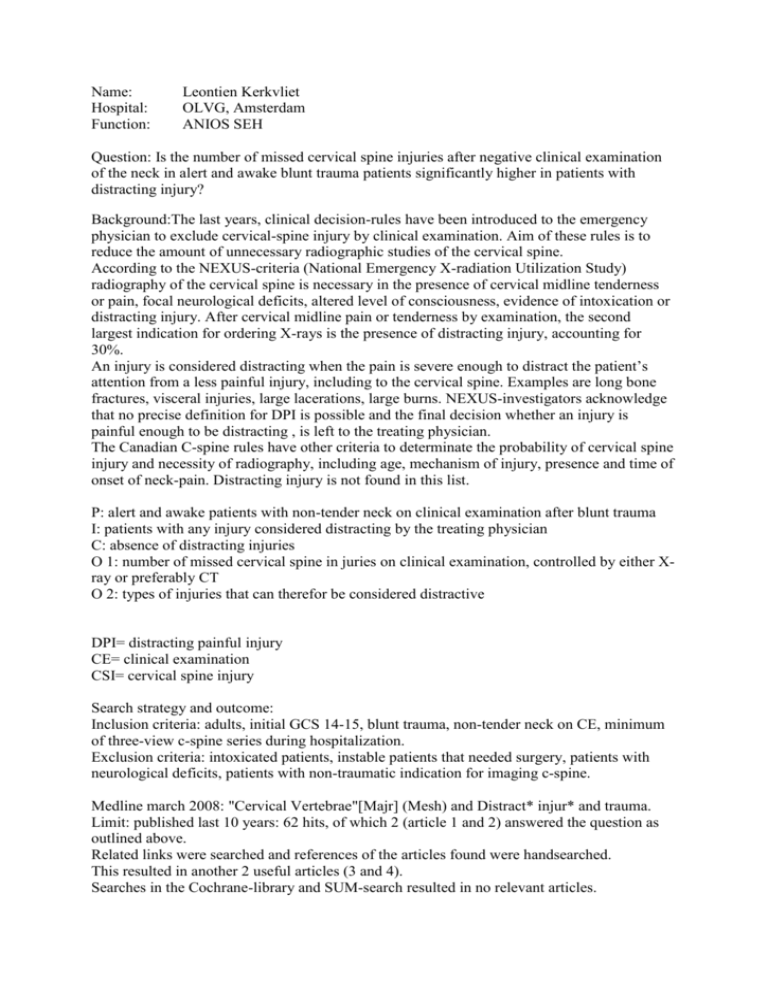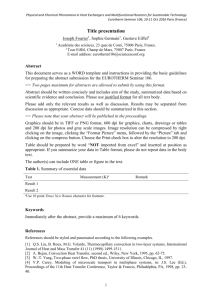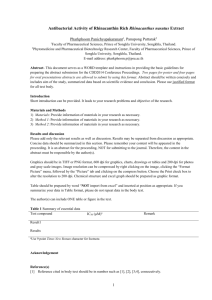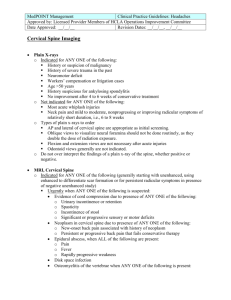Leontien Kerkvliet
advertisement

Name: Hospital: Function: Leontien Kerkvliet OLVG, Amsterdam ANIOS SEH Question: Is the number of missed cervical spine injuries after negative clinical examination of the neck in alert and awake blunt trauma patients significantly higher in patients with distracting injury? Background:The last years, clinical decision-rules have been introduced to the emergency physician to exclude cervical-spine injury by clinical examination. Aim of these rules is to reduce the amount of unnecessary radiographic studies of the cervical spine. According to the NEXUS-criteria (National Emergency X-radiation Utilization Study) radiography of the cervical spine is necessary in the presence of cervical midline tenderness or pain, focal neurological deficits, altered level of consciousness, evidence of intoxication or distracting injury. After cervical midline pain or tenderness by examination, the second largest indication for ordering X-rays is the presence of distracting injury, accounting for 30%. An injury is considered distracting when the pain is severe enough to distract the patient’s attention from a less painful injury, including to the cervical spine. Examples are long bone fractures, visceral injuries, large lacerations, large burns. NEXUS-investigators acknowledge that no precise definition for DPI is possible and the final decision whether an injury is painful enough to be distracting , is left to the treating physician. The Canadian C-spine rules have other criteria to determinate the probability of cervical spine injury and necessity of radiography, including age, mechanism of injury, presence and time of onset of neck-pain. Distracting injury is not found in this list. P: alert and awake patients with non-tender neck on clinical examination after blunt trauma I: patients with any injury considered distracting by the treating physician C: absence of distracting injuries O 1: number of missed cervical spine in juries on clinical examination, controlled by either Xray or preferably CT O 2: types of injuries that can therefor be considered distractive DPI= distracting painful injury CE= clinical examination CSI= cervical spine injury Search strategy and outcome: Inclusion criteria: adults, initial GCS 14-15, blunt trauma, non-tender neck on CE, minimum of three-view c-spine series during hospitalization. Exclusion criteria: intoxicated patients, instable patients that needed surgery, patients with neurological deficits, patients with non-traumatic indication for imaging c-spine. Medline march 2008: "Cervical Vertebrae"[Majr] (Mesh) and Distract* injur* and trauma. Limit: published last 10 years: 62 hits, of which 2 (article 1 and 2) answered the question as outlined above. Related links were searched and references of the articles found were handsearched. This resulted in another 2 useful articles (3 and 4). Searches in the Cochrane-library and SUM-search resulted in no relevant articles. Author, date Patient group Study type Intervention Comparison Outcomes Results Study weaknesses Heffernan, 2005 406 adults blunt trauma, GCS 15 Prospective observational , blinded Upper torso distracting injury non-tender neck Lower torso distracting injury non-tender neck Number of # on X-ray in pts with nontender neck on CE Nontender neck and #: 7/239 DPI upper torso: 7/140 # DPI lower torso: 0/99 # (p=0,04) Plain X-ray as golden standard despite low sensitivity Small no # with ne CE Prospective cohort, blinded Types of DPI and vertebral # in pts with non-tender neck Types of DPI and Types of DPI no vertebral # in with # and no pts with non-tender neck-pain neck 8 pts had # in 336 pts 1 pt with CSI (subluxation C1) 7 thoraco-lumbal spine injury All 8 pts had bony fractures as DPI Small no # with DP as only indication Not all injuries wel documented on initial data sheet No n of pts neg CE without DPI and # Prospective observational, blinded Missed # on clinical examination Missed # on plain X-rays 33 CSI, 3 nontender neck on CE, 2 with DPI Types of DPI: bony # 13 CSI missed on X-ray Not all pts received CT as referencetest No number of pts with DPI in total an DPI without # Prospective observational, blinded Distribution of CSI in pts with DPI 37 CSI 19 with DPI (51,4%) 3 DPI only indication (8,1%) all fractures No total number of pts who underwent X only for DPI Referencetest X-ra Only CT on indication Age 1 month-99 yr Non-tender neck 239 pts Chang et al, 4698 patients 2003 blunt trauma GCS 15 Non-tender neck and DPI 336 pts Gonzalez et 2176 adults al, 1999 blunt trauma, GCS 14-15 Non-tender neck 1768 pts Ullrich et al, 2001 778 pts blunt trauma. 264 patients with DPI Sensitivity of CE regardless of DPI vs sensitivity of X-ray. Golden standard CT Distribution of CSI Frequency in pts without DPI and nature of DPI associated with CSI Conclusion: All studies mentioned above agree on the subjectivity of the term ’distracting’. One study concludes the NEXUS-criteria may be narrowed to DPI of the upper torso. 2 Studies only mention bony fractures as distracting. In none of the studies visceral injuries, crush-injuries and burns are correlated with higher incidence of CSI. Refinement of the NEXUS-criteria could result in fewer radiographs needed to be ordered. Level of recommendation: B. Comments: The referencetest used in most of the studies mentioned is the plain cervical spine film, although the well-known and acknowledged low sensitivity. Further research needs to be done to examine the additional value of plain X-rays after negative clinical examination . All patients in the studies above are blunt-trauma patients with an initial GCS of 14 (in one study) or 15. No extrapolation can be made for patients with decreased level of conscioussness. Pain is subjective. Clinical bottom line: To rule out cervical spine injury in alert and awake blunt trauma patients with distracting injuries, the treating physician has to be aware of the types of injuries that actually mask pain in the cervical spine and can therefor be considered distractive enough to miss cervical spine injury. References: 1. David S. Heffernan, MD, Carol R Schermer, MD, MPH, Stephen W Lu, MD. What defines a distracting injury in cervical spine assessment?. Journal of trauma 2005;59:1396-1399. 2. Cindy H Chang, MD, James F Holmes, MD, MPH, William R Mower, MD, PhD, Edward A Panacek, MD, MPH. Distracting injuries in patients with vertebral injuries. Journal of emergency medicine 2005; 28 no 2: 147-152. 3. Richard P Gonzalez, MD, Peter O Fried, MD, Mikhail Bukhalo, Michele R Holevar, MD, FACS, Mark E Falimirski, MD. Role of clinical examination in screening for blunt cervical spine injury. Journal American College of Surgeons 1999;189:152-157. 4. Ann Ullrich, MD, Gregory W Hendey, MD, Joel Geiderman, MD, Sandi G Shaw, RN, jerome Hoffman, MA, MD, William R Mower, MD, PhD, for the NEXUS-group. Distracting painful injuries associated with cervical spine injuries in blunt trauma. Academic emergency medicine 2001; 8:25-29.







